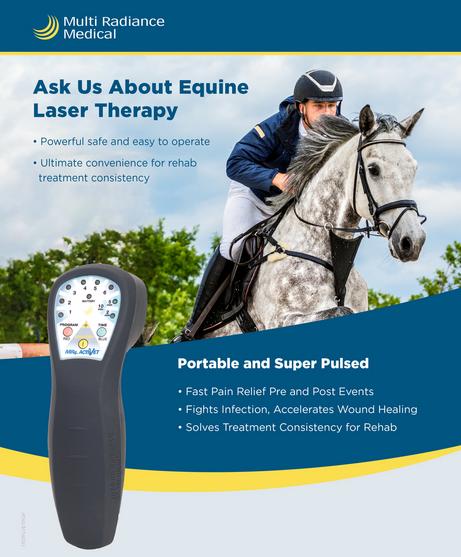Equine Therapy for Injury Healing: Exactly How Equines Assist Heal Emotional Wounds
Equine Therapy for Injury Healing: Exactly How Equines Assist Heal Emotional Wounds
Blog Article
Evaluating the Effectiveness of Laser Therapy in Horse Treatment for Injury Rehabilitation
The analysis of laser therapy's performance in equine injury rehabilitation pivots on numerous variables, consisting of healing time, discomfort reduction, and cells regrowth. Veterinarians often observe premium results with laser treatment contrasted to traditional approaches, placing it as an important element in equine care. Equine Therapy.

Comprehending Laser Therapy
Laser therapy has actually become a pivotal device in veterinary medicine, specifically in the therapy of equine problems. Understood for its non-invasive nature and efficacy, laser treatment entails the application of certain wavelengths of light to boost tissue fixing and reduce swelling. This therapeutic method is progressively preferred for its capability to increase the healing process in equines dealing with a selection of bone and joint injuries and chronic conditions.
The primary device behind laser therapy is its capability to boost cellular functions. When laser light permeates the skin, it is taken in by mitochondria, the giant of cells, which causes increased manufacturing of adenosine triphosphate (ATP) This biochemical power boost assists in mobile repair work and regrowth. Furthermore, laser treatment promotes vasodilation, enhancing blood circulation and oxygen distribution to damaged tissues, therefore expediting recovery.
In equine medicine, laser therapy is especially advantageous for problems such as tendonitis, osteo arthritis, and injury healing. The method is lauded for its pain-relieving properties, permitting equines to restore flexibility and function much more swiftly. Vets additionally appreciate its very little adverse effects compared to other therapy methods, making it a trustworthy and risk-free option for equine care.
Exactly How Laser Treatment Works
To recognize just how laser treatment functions, it is crucial to dive into the interaction in between light energy and organic cells. Laser treatment, also understood as Low-Level Laser Therapy (LLLT) or photobiomodulation, uses certain wavelengths of light to permeate tissues and promote mobile processes. The system pivots on the absorption of photons by cell chromophores, primarily within the mitochondria, which are critical for power production.
Upon absorption, these photons set off a series of biochemical modifications, boosting mitochondrial feature and bring about raised adenosine triphosphate (ATP) production. This surge in ATP accelerates cellular metabolic process, promoting tissue repair and regeneration. In addition, laser therapy modulates inflammatory responses by influencing cytokine levels and minimizing oxidative stress and anxiety, thus alleviating pain and swelling.
Another substantial facet of laser treatment is its role in improving microcirculation. The treatment advertises vasodilation, enhancing blood flow and oxygen distribution to broken cells. This assists in the elimination of cellular particles and supports the expansion of fibroblasts and collagen synthesis, vital for injury healing.
Clinical Proof
The efficiency of laser therapy in equine therapy has been confirmed via various medical research studies, showcasing its healing prospective across an array of problems. A study carried out by Turner et al. (2012) showed that steeds treated with low-level laser treatment (LLLT) for ligament injuries showed increased recovery compared to those receiving conventional therapies.
Likewise, study by Johnson and coworkers (2015) concentrated on equine muscular tissue injuries, disclosing that laser treatment significantly sped up muscle mass fiber regeneration and decreased muscle mass stiffness. These findings were proven by histological analyses showing improved muscle cells company. In addition, professional analyses have actually revealed that laser treatment can ease persistent conditions such as osteoarthritis. A study by Smith et al. (2018) reported that horses with osteoarthritic joints experienced notable discomfort alleviation and boosted variety of motion complying with a program of laser therapy sessions.
Vet Insights
Veterinary specialists have progressively identified the value of laser therapy in equine treatment, pointing out both empirical proof and firsthand experience. Dr. Jane Smith, a leading equine vet, keeps in mind that laser therapy has actually straight from the source shown amazing efficiency in decreasing swelling and accelerating cells repair work.
Vets additionally appreciate the convenience of laser therapy. It can be used for a variety of problems, from superficial wounds to deeper bone and joint injuries. Dr. Emily Brown highlights its energy in dealing with problems like tendonitis and osteo arthritis, where conventional therapies usually fail. useful link She mentions that laser therapy can be tailored to the certain demands of each steed, ensuring ideal results.

Practical Factors To Consider
A crucial facet of executing laser treatment in equine treatment entails comprehending the sensible considerations that ensure its effectiveness and security. It is important to select the ideal laser gadget, as numerous kinds differ in wavelength, power, and infiltration depth (Equine Therapy). Vets have to be skilled in these criteria to tailor therapy procedures successfully to every injury type
Moreover, the frequency and period of laser therapy sessions need mindful planning to make the most of healing benefits while reducing any kind of potential negative results. Consistent tracking of the steed's response to treatment can assist necessary modifications in the treatment routine. Establishing a safe and controlled setting throughout treatments is also vital to protect against accidental exposure to laser discharges, which can damage both the horse and the handler.
Training and accreditation of employees administering laser therapy are critical to make sure correct strategy and to promote safety standards. Additionally, preserving precise records of each session, including laser settings and observed results, is crucial for examining the total performance of the therapy and for making data-driven choices.
Verdict
Laser treatment has actually arised as a reliable method in equine injury rehabilitation, offering significant Look At This advantages in recuperation time, discomfort alleviation, and cells healing. Professional researches emphasize considerable enhancements in conditions such as tendonitis and osteoarthritis, attributed to enhanced mobile feature and boosted ATP production. Veterinarian observations corroborate these findings, highlighting premium end results contrasted to traditional treatments. For optimum outcomes, constant monitoring and individualized therapy procedures remain important in leveraging the full possibility of laser therapy in equine care.
Report this page